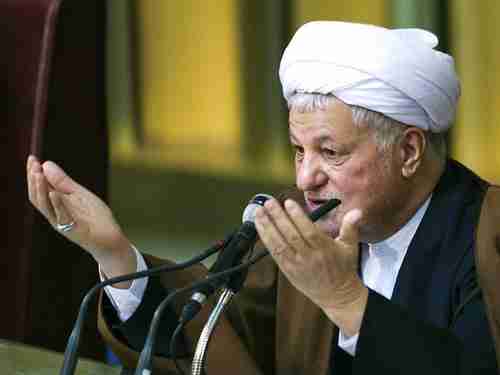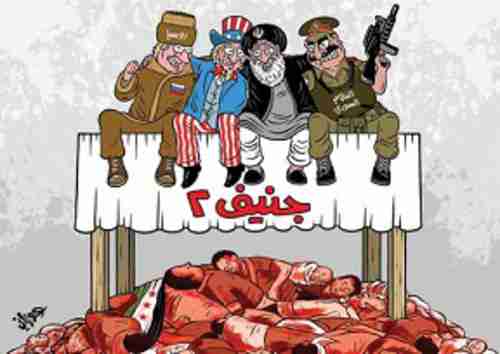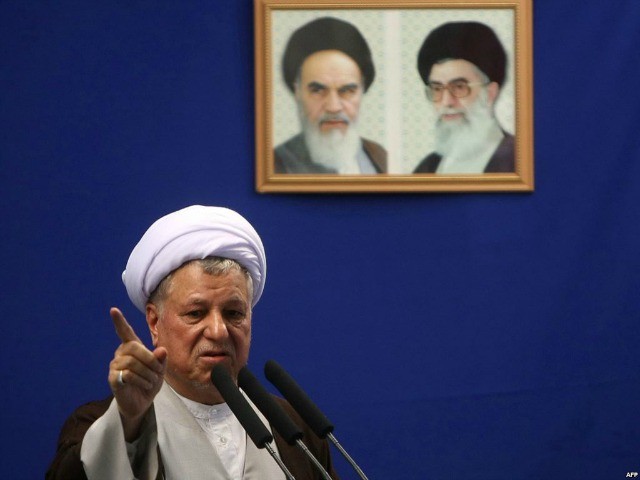
This morning’s key headlines from GenerationalDynamics.com
- Power struggle in Iran would follow death of Supreme Leader
- Iran’s negotiations with America represent a Rafsanjani victory over Khamenei
- ‘Death to America!’ to be featured on Iran’s American embassy anniversary
- Saudi Arabia turns against U.S. over Russia / Iran negotiations
Power struggle in Iran would follow death of Supreme Leader

Ali Akbar Hashemi Rafsanjani
Iran’s Supreme Leader, Ayatollah Seyed Ali Khamenei, has not been seenin public since October 5, and there are reports that his health isfailing and that a power struggle is brewing.
If there is change, a likely successor as the new Supreme Leader wouldbe Ali Akbar Hashemi Rafsanjani. Like Khamenei, Rafsanjani was one ofthe survivors of the 1979 Great Islamic Revolution. When the originalSupreme Leader (Ayatollah Rouhollah Khomeini) died in 1989, Khameneibeat out Rafsanjani for the role of new Supreme Leader.
The two have been vigorous rivals since then, and in 2009, Rafsanjaniwas a leader of the opposition to the election of Mahmoud Ahmadinejad.Rafsanjani is still a hardcore believer in the Islamic state, but he’sconsidered a reformist leader and is a representative of the views ofthe younger generations that grew up after the Islamic Revolution and have no personal memory of it.
Iran is in a generational Awakening era, meaning that a generation haspassed since the end of the last generational crisis war. The resultis a “generation gap” between the survivors of the last crisis war andthe younger generations growing up after the war. In America’sAwakening era of the 1960s, the WWII survivors were concerned aboutstopping Communism in Vietnam, while the younger generation (theBoomers) were opposed to the Vietnam war and supported political andgender equality and compromise with the Soviet Union.
Today, Iran is following a similar path. I’ve written many articlesin the last few years about young women demanding to be allowedto dress without headscarves (just as young women in the 1960swore miniskirts and hot pants). And there have been largeanti-government student demonstrations for years, peakingin the 2009 election.
Every Awakening era reaches a climax that ends in one ofonly two ways: The younger generation “wins,” as happened inAmerica when President Nixon resigned in 1974, or the oldergeneration “wins,” as happened in China in 1969 with theTiananmen Square massacre.
Despite the 2009 crackdown against the student protesters, all signspoint to an Awakening era victory by the younger generation. IfRafsanjani replaces Khamenei as the Supreme Leader, that will signalthe beginning of the Awakening era climax. YNet
Iran’s negotiations with America represent a Rafsanjani victory over Khamenei
During the past few months, I’ve written about a possibly significantchange in the rhetoric of Iran’s Supreme Leader, Ayatollah Seyed AliKhamenei. In particular, he’s been using a phrase with enormoushistoric significance, “heroic flexibility,” to justify arapprochement with America. I’ve written that this change was forcedon him by the rise of the younger post-Revolution generations inIran’s generational Awakening era. A series of analyses by the MiddleEast Media Research Institute (MEMRI) shows that the mechanism bywhich this occurred was through a series of political battles betweenKhamenei and Ali Akbar Hashemi Rafsanjani.
Rafsanjani still holdshardcore beliefs in the Islamic state, but he has sided with theyounger generation in supporting engagement with the U.S. in thespirit of “Islamic Realism” — updating and adapting the values ofthe Islamic Revolution to the spirit of the times to conduct adialogue with the U.S., instead of leading Iran down an extremist pathfor the sake of an ossified “false idealism.” Rafsanjani hassuccessfully created a schism in Khamenei’s camp by forcing him toagree to direct talks with the U.S. and to become more flexible inother ideological issues. MEMRI andMEMRI
‘Death to America!’ to be featured on Iran’s American embassy anniversary
The bitter political struggle between the camps of Iran’s SupremeLeader Ayatollah Seyed Ali Khamenei and Ali Akbar Hashemi Rafsanjaniwill be particularly apparent on Monday, November 4, which is the 34thanniversary of the takeover of the the American embassy in Tehran,leading to Iran’s Great Islamic Revolution. The phrase “Death toAmerica!” is a cornerstone of the Great Islamic Revolution, and everypatriotic Iranian must be willing to chant this phrase on almost anyoccasion (“I do, and Death to America”). Rafsanjani has called forthe elimination of this chant, because it accomplishes nothing and itprevents engagement with the U.S. However, the Khamenei camp saysthat the chant encourages nationalism, and opposing the chant is disrespectful to Iran and Islam:
It is the enemies’ plan to isolate and disrespect thenation. It is the enemies’ plot that some have dreamed that theImam was against Death to America. Are we in a leaderless statewhere some can dream and say that the Imam was against Death toAmerica. The Supreme Leader does not allow these memories.
Death to America is rooted in the Quran. This slogan means hatredof Yazid [the caliph who killed Imam Hossein during thetransformational Battle of Karbala in 680].
During Monday’s celebrations of the takeover of the American embassy,the pro-Khamenei camp has promised that “Death to America!” will bechanted with special gusto. MEMRI andAEI Iran Tracker
Saudi Arabia turns against U.S. over Russia / Iran negotiations

This Saudi cartoon portrays Russia, U.S., Iran and Syria as pals, above the corpses of Syrian victims (Al-Watan, Saudi Arabia / Memri)
Starting with its policy of turning against Egypt’s Hosni Mubarak whenthe Egyptian Revolution began in 2011, the Obama administrationappears to be determined to do everything possible to alienate itsone-time ally, Saudi Arabia. The Saudis were shocked as Syria’spresident Bashar al-Assad massacres hundreds of thousands of innocentArab civilians and drives millions of them from their homes toneighboring countries. They were then deeply insulted and offended that theObama administration is negotiating deals with Iran, Saudi Arabia’s bitterenemy, and with Russia; deals that will leave al-Assad in power andessentially reward him for his genocidal massacre.
The Saudis arevery concerned about a deal between the U.S. and Iran that permitsIran to develop nuclear weapons. They’re not concerned about Iran’suse of them on Israel; they’re concerned that they’ll be used onSaudi Arabia, and those concerns are justified. The Saudis arelooking for ways to derail negotiations between the U.S. and Iran.Debka, which sometimes gets things wrongs, quotes its intelligencesources as saying that the recent terrorist attack on Iran’sRevolutionary Guards by Jaish al-Adl (the Army of Justice) that we reported a few days ago wereactually arranged by the Saudis, working hand in glove with thegovernment of Pakistan. If this is true, then we can expectretaliation from Iran, possibly creating a “war of terror” between thetwo countries.
Long-time readers are aware that for years I’ve been saying that theapproaching Clash of Civilizations world war would pit China, Pakistan, Saudi Arabia, and others versus the U.S., India, Russia, and Iran. In recent months, Mideast geopolitics have been realigning tomatch this prediction. MEMRI andDebka
KEYS: Generational Dynamics, Ayatollah Seyed Ali Khamenei,Iran, Ayatollah Akbar Hashemi Rafsanjani,Saudi Arabia, Jaish al-Adl, the Army of Justice,Pakistan, Syria, Bashar al-Assad

COMMENTS
Please let us know if you're having issues with commenting.